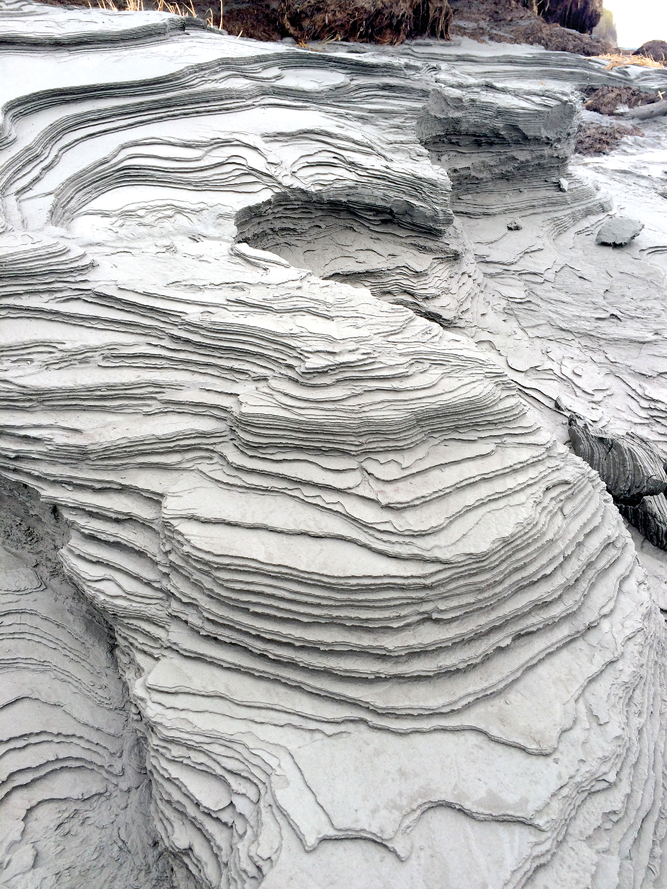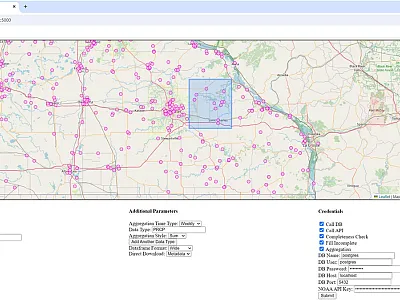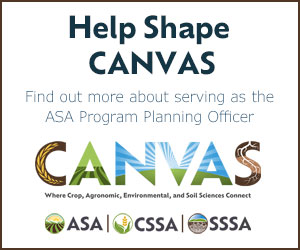Soils Are Awesome—and Beautiful!

Near the end of a long strategic planning session in last July, 2023 SSSA President Carrie Laboski exclaimed that “Soils are awesome!”—a phrase that still resonates with me (see Dr. Laboski’s column from last November: https://doi.org/10.1002/csan.21163). My goal in this column is to convince you (if you need convincing) that one aspect of that awesomeness is their beauty. But I want to start this reflection with some thoughts about the nature of science in general.
I believe that science is primarily an endeavor to systematically identify and interpret patterns. Of course, pattern recognition is something human beings strive to do “naturally”—except for the systematic part. Science imposes an orderly approach to making observations and testing hypotheses to recognize patterns. Then our interpretations of those patterns help us to understand the ways the universe has worked up to this moment as well as to predict how it will work in the unknown future. Through science we seek to tell stories of the world around us and within us. And in doing so, we often perceive great beauty in the patterns that we observe.
While philosophers of aesthetics over the ages have pondered the nature of beauty, what follows is a purely personal and naïve perspective on the topic. Table 1 lists the kinds of patterns that, in concert with one another, can evoke the perception of beauty for me.
| Sensory beauty | Functional beauty | Meaningful beauty |
|---|---|---|
| Symmetry/shape | Measurable attributes | Continuity with patterns that I know or expect |
| Balance/proportion | Simple enough for basics to be understood | Continuity with patterns that I know or expect |
| Continuity | And yet complex enough to be interesting | And yet also—surprising insights, predictions, or perspectives |
| Light/color/shadows/darkness | Spatial and temporal continuity in function | An embedded and engaging story |
| Rhythm | Integration of multiple functions | An integration of sensation, intellect, and emotion |
| Movement/change/sequence | Vital to sustaining life | An acceptance and even celebration of mystery |
| Variety/diversity/juxtaposition/contradiction | ||
| And yet—harmony |
You may have a different list of patterns that lead you to regard something as beautiful. But we can all perceive beauty around us in some way. Some of it is created by other humans in the form of art—visual arts, music, dance, poetry, prose—as well as in acts of dedication, service, and love that we offer to one another. We also perceive beauty in the planet we live on—mountains, plains, and coastlines; forests and grasslands; great rivers and oceans—and the countless organisms we share the planet with. What makes these things beautiful to us? I think it’s because we recognize patterns like those in Table 1. Those recognitions may be comforting or challenging, but they can engage us on multiple levels.
Let me turn to beauty in the context of soils. In soils, I see three kinds of beauty: sensory, functional, and meaningful.
Sensory Beauty
Consider a painting, a photograph, a poem, or a musical composition that you think is beautiful. What grabs your attention? What comforts you or challenges you about it? There are likely to be some familiar patterns, something you recognize that is directly or indirectly consistent with what you have seen or heard before by using senses like your vision or hearing. There is also likely to be diversity of color, melody, or harmony as well as novelty in some patterns—all of which contribute to its perceived beauty.
Such a sensory, aesthetic perception of beauty may also happen as you study a photo of a soil profile or, better yet, as you stand in a soil pit or before a road cut and observe patterns of contrasting or complimentary horizons. Perhaps it is the vertical arrangement of colors that first catches your eye. But further investigation reveals repeating visual patterns of pedality and porosity, redoximorphic features and coatings of clay. Some of my most pleasant working hours have been spent describing soils—matching colors; nudging peds away from their matrix for close examination of shape, size, and surfaces; and pressing wetted masses of soil between my fingers to assess texture. Maybe I am alone in these feelings of connection with soil, but it seems like such a privilege to get to know a soil up close and personal with the intimacy of visual, tactile, and sometimes olfactory and gustatory senses. The patterns that I record (to interpret and communicate with others) are elements of beauty—patterns of sequence, shape, proportion, and connectedness. Novelty and surprises are often included if I am ready to notice them. It’s awesome, and it’s beautiful.

Many of us have a sense of awe when we view images taken by the Hubble space telescope. In Figure 1, on the left panel, we see swirls of several colors with gradual boundaries in some places and sharp boundaries elsewhere. We see an elongated thread that curls from the lower left corner of the image to the upper right. There is a cluster of bright objects in the center of the image. In the background lies the constant continuity of space, but it is a darkness that is punctuated throughout by bursts of light, some faint, others brilliant and luminous. Even when we don’t know the particulars of how stars form in space or how the energy of star formation can redistribute gases and dust, the image is beautiful.
Such awe also occurs as I look at thin sections where soils are encountered at the millimeter or micrometer scale. For example, the right panel of Figure 1 shows a two‐dimensional image of the Btg horizon of a Typic Argialboll in Iowa. The spatial patterns of quartz grains, clay intercalations and coatings, and iron oxide accumulations are stunning in juxtaposition to one another. Even if we don’t know what the components are, we may perceive an inherent beauty in the patterns and diversity of colors, shapes, and connections.
Perhaps not all soils can be readily recognized by their beauty. I think especially of those soils that have been severely disturbed or destroyed by urbanization or by human warfare. But even in damaged soils, we may perceive a hint of beauty in the subtle shadows, in the diversity of textures, or the cataclysmic repositioning of horizons. We are told that all beauty is “in the eye of the beholder,” and surely this is the case. So let’s open our eyes! Our contemplation of the purely aesthetic beauty of a soil is an opportunity to see it in multiple dimensions and from a fresh perspective, expanding our appreciation beyond the familiar, cultural patterns of our upbringing so that we can behold something new.
Functional Beauty
Soils certainly have functional beauty because of their value, and it is invaluable to humankind that most soils are amenable to management. Soils sustain life; they are, after all, what we depend on for food, fiber, fuel, clean water, and more. Functional beauty plays out especially in the temporal dimension, I think. The crops that we raise depend on soils for seasonal patterns of nutrient storage and release as the roots of those crops are anchored cozily in an organized milieu of solids, liquid, and gas. There are regular and irregular pulses of growth of cohabiting microorganisms as they decompose organic matter, and there is symmetry in the uptake and discharge of water by roots on a diurnal basis. These processes (and many more, of course) function together, supporting not only plant life, but—directly or indirectly—all of the other organisms that inhabit soils, from bacteria to ants, from worms to foxes. These functional patterns each have their own beauty, playing out in concert with the rain and the sun and the farmer. We can perceive balance, rhythm, movement, harmony, diversity, and unity in soil functions.
Meaningful Beauty
The third kind of beauty is deeply connected to the first two. Beauty that is meaningful arises from the alignment of form and function; in other words, the interweaving of sensory beauty with functional beauty. In that alignment, soils reveal meaningful stories. Many familiar soil science stories come to mind: cycles of carbon, nitrogen, phosphorus, or sulfur, for example. Here, I will highlight the pattern of soils on the landscape. When we learn to interpret them, county‐scale soil survey maps (those at the 1:15,840 scale, for example) can be beautiful depictions of landscape‐scale patterns. They suggest landscape‐scale stories with common themes, surprising variations, and historical echoes that can help us to predict how the future soilscape will unfold. When they are revealed in early morning light and shadows, the warp and weft of the land surface reflect cyclic processes of drainage, weathering, erosion, and deposition. Soils on summits, side slopes, foot slopes, and floodplains can vividly tell us their individual stories. Some of the events in those stories encompass gradual changes over thousands of years while other events were so rapid as to be catastrophic. We have many wonderful tools today to help us interpret those stories—LIDAR, luminescence dating, stable isotopes and radioisotopes, portable XRF units, in situ sensors, and new statistical approaches to detect underlying patterns, to name a few. We need landscape‐scale stories to ascribe large‐scale meaning to those data that are derived from samples collected at particular positions on the landscape. Landscape‐scale stories are vital not only for pedogenic knowledge, but also for large‐scale management of agronomic fertility and soil carbon.
There are stories to tell at every scale. The megascopic image of the left panel of Figure 1 invites us to wonder at the incredible energy of new star formation and at the unfathomable distances that light must travel to reach our eyes. The microscopic image on the right panel of the figure is beautiful because it tells stories of rooting patterns, of clay translocation and deposition, and of mineral weathering that has mobilized soluble iron, leading to precipitates of new iron oxide minerals. In both images, we are invited to integrate the sensory with the functional to perceive a new, deeper appreciation that expands our perspective far beyond our human‐focused world.
We humans have the wonderful gift of devising and sharing complex, entertaining, and informative stories with one another. These narratives of history, hope, logic, or emotion are passed on orally, through written form in prose or poetry, or through other artistic forms like music, dance, sculpture, or painting. This capacity, at least in degree, is one thing that distinguishes our species from others. This is also what soil scientists do—we systematically look for patterns in soils by observation and testing hypotheses, and then we create stories to help us interpret the past, understand the present, and predict the future. We call our stories models, and we strive to make them elegant, balanced, harmonious, and unified. Our best models may also provide new insights and perspectives that challenge the boundaries of our understanding. They acknowledge and incorporate the mysteries that we do not yet understand. In all those ways, they have great beauty. As soil scientists explore the sensory and functional beauty of soils, we create meaningful stories that enrich and give context to the history and life of our planet. These are awesome and beautiful stories to share with everyone.
Acknowledgments
Many thanks to J.R. Thompson, M.E. Thompson, R.E. Davenport, K.A. Heckman, and H.R. Reitmeier who helped to edit, clarify, and improve this reflection.
Please Read Dr. Garland‐Campbell’s Column in This Issue
I would like to encourage everyone to read the informative column that Kim Garland‐Campbell, the CSSA President, has written for this issue of CSA News magazine. It deals with the importance of mentoring in professional development and with some of the new initiatives that ASA, CSSA, and SSSA are jointly working on to better serve our members. You will learn why both mentoring and being mentored can be opportunities for growth throughout one’s career.
Text © . The authors. CC BY-NC-ND 4.0. Except where otherwise noted, images are subject to copyright. Any reuse without express permission from the copyright owner is prohibited.







